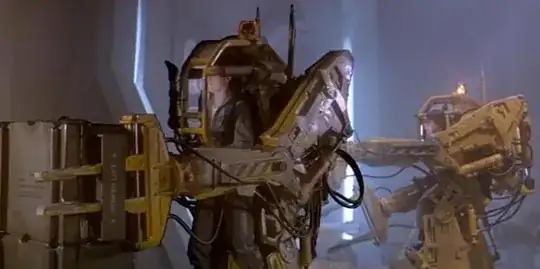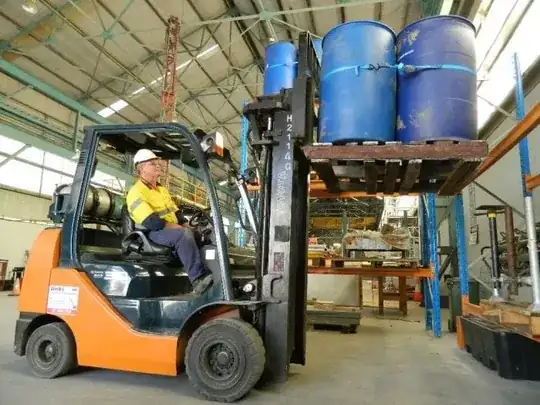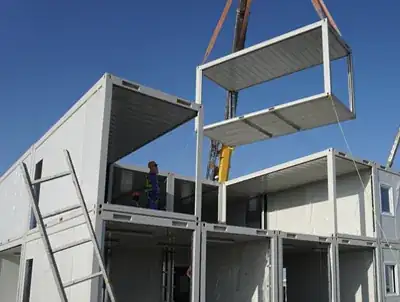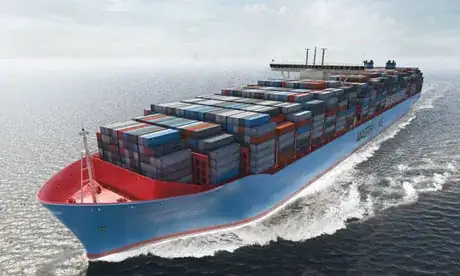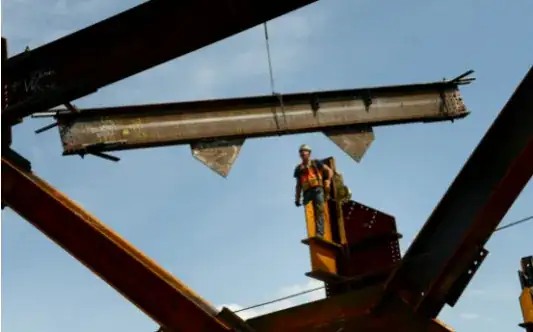What non-combat uses could mechs have? While mechs are obviously inferior to wheeled & tracked vehicles in combat. What uses could they have out of combat both military & non military? They have to it better than a wheeled or tracked vehicle, otherwise it would just be better to use them. It can't be done just as well or better by fitting arms to a truck or tracked chassis, otherwise you would just put the arms on one of those. So what could mechs be used for out of combat?
-
4Mechs are as obviously inferior to wheeled/tracked vehicles as a wheeled vehicle is inferior to tracked vehicles: they aren't inferior, they just have different places where they can be used. One of the big "problems" with mechs according to everyone is the surface area of their feet, but you don't design mech feet like a game designer, you design it to have a purpose. The whole point of feet is that unlike tracks or wheels they DON'T need a specific facing direction to move. This gives you a lot more freedom in both size and shape of the feet for various terrain surfaces. – Demigan Aug 23 '21 at 09:59
-
1Could you clarify the exact shape and usage of the mechs? A humanoid mech that takes the exact movement of its user is a much more versatile mech than a legged mech with just a cockpit and weapons bolted on top. – Demigan Aug 23 '21 at 10:04
-
@Demigan if its got legs & arms its a mech. it could be a spider mech with 3 excavator arms on top for all i care. i just need to get a justification to have legged vehicles in semi-common use. – OT-64 SKOT Aug 23 '21 at 10:12
-
1Any workload where humans currently use machines to assist them... so literally everywhere. Construction, distribution (loading and offloading goods), mining... – Ian Kemp Aug 23 '21 at 11:07
-
2"Mechs are obviously inferior to wheeled & tracked vehicles in combat." Why? – Evorlor Aug 23 '21 at 12:50
-
2@Evorlor https://worldbuilding.stackexchange.com/q/10320/73451 read through this – OT-64 SKOT Aug 23 '21 at 13:03
-
Since you compare it to "vehicles", does this assume mechs are manned? Or that they're at least the size of a human? If the requirement is legs and arms, an RC EOD bot on legs with a robotic arm would be a mech. – AmiralPatate Aug 23 '21 at 13:24
-
@AmiralPatate it is assumed they are manned. – OT-64 SKOT Aug 23 '21 at 13:30
-
2In Patlabor mechs are used for contruction, and perhaps other stuff, and policing. – Pablo H Aug 23 '21 at 14:37
-
I'm thinking of the Theirs Not To Reason Why series--it has mechs that are basically armed, powered armor--much more useful in boarding operations than a tank would be. They are also used when loading cargo and the like. – Loren Pechtel Aug 24 '21 at 02:54
-
Maybe take a look at what Boston Dynamics is advertising their mechs for: working in toxic or otherwise dangerous environments with rough terrain that cannot be handled by a vehicle (tight corners, steps, debris, ...) – arne Aug 24 '21 at 04:09
-
@OT-64SKOT All of those assume that the same rules that apply to tanks today apply to mechs in the future, with zero advances in physics and technology to change the equation. While there are certainly some physical rules like the square-cube law that are almost certainly constants, there are many others that humans have figured out how to circumvent - e.g. making things that are far heavier than air fly through the air. Writing off mechs as infeasible in 2021 is about as smart as writing airplanes off as infeasible in 1821. – Ian Kemp Aug 24 '21 at 07:33
-
1@IanKemp The thing about mechs is that its not like that at all. It'd be like saying if you could make aircraft that flap their wings to fly it would be stupid in 2121 because it was stupid in 2021. The thing about mechs is that if built they would be worse in almost all ways to tanks in combat. If you have a technology that allow you to make mechs, you would be better off using to make a better tank. That's why this question focuses on on-combat uses, where there some of their biggest disadvantages aren't as severe as for in combat. – OT-64 SKOT Aug 24 '21 at 07:59
-
"The thing about mechs is that if built they would be worse in almost all ways to tanks in combat." That's a conclusion you've made based on knowledge that you have today. That conclusion would be completely invalidated if, for example, microgravity generators were developed that allowed mechs to be supermanoeuvrable. – Ian Kemp Aug 24 '21 at 08:09
-
1@IanKemp The thing is, why wouldn't you fit microgravity generators to a tank? If you can make a mech supermaneuverable using microgravity generators, why not fit tanks to be able to use it & have all the advantages of a tank. (And microgravity generators would cause severe issues by themselves due to the fact that you also need gravity to keep particles together) – OT-64 SKOT Aug 24 '21 at 08:13
-
@OT-64SKOT Because a tank has less to gain from them vs a mech. A humanform mech with such devices could theoretically move similarly to an actual human, which opens up a vast array of combat possibilities. A tank with such devices would... be able to float, or mount more armour, or a bigger gun. Which are very useful combat capabilities, but rather boring. – Ian Kemp Aug 24 '21 at 08:25
-
1@IanKemp The thing is that floating is still going to be better than human style movement. The ability to climb a cliff or building is redundant when a tank could have just floated up there. While still having all the advantages of a tank that it has over a mech. Even if it cant float, you can fit something to it to pull the tank vertical & use something like a propeller to the the back to keep it from falling. – OT-64 SKOT Aug 24 '21 at 08:41
16 Answers
This question is a bit difficult to answer because 'Mech' could describe a tracked vehicle with a mech upper torso, a quadripedal spider-like mech, a bipedal humanoid mech.. an underwater ROV with mech arms.. the possibilities are wide and we already use machines like this in a lot of real world applications.
I'm going to discount tracks here, because they tear up paved surfaces and are very high maintenance. They're great for the outdoors and marginal terrain but if they're being transported over paved roads they ride on a flatbed truck. It is debatable whether a tracked vehicle or a mech have better rough-terrain handling characteristics. I freely grant a tracked vehicle can carry more armor and heavier weapons though.
Let's just take a basic example of the Powerloader from Aliens vs a Forklift: Both have articulated, electro-hydraulic arms. The powerloader can lift a load higher than a forklift can, by utilizing the stabilizing mechanisms that keep it upright. A forklift can only lift so high before it is in danger of tipping over. If that starts happening, the only thing a forklift driver can do is hold on for dear life, whereas a powerloader driver could at least try to correct the imbalance.
A forklift also needs to be able to drive straight in to pick up its load, which can be a challenge in a crowded loading dock. A powerloader can walk right up to it from any angle and just grab it. The forklift then has to back out, get turned around and land its load the same way. It has a longer body, so requires more space to maneuver. The powerloader could just turn without backing up and walk back the way it came with 0 turning radius or need to 3-point turn.
In terms of maintenance complexity, the mech is probably going to take slightly more maintenance than the forklift because it has more articulated parts, OTOH its trading off the wheels, steering system, brakes, tires, etc of the forklift. I think maintenance is a tie.
- 1,349
- 5
- 10
-
1The ability for a mech to stay upright is non-trivial. There's a reason why videos of robots walking is actually interesting. The picture shown makes no sense because it is still in upright position while there is a load sticking out of them. The box is probably Styrofoam and weights nothing. If you see a real person carrying a heavy box, they do not stay upright. – Nelson Aug 23 '21 at 04:05
-
It isn't the most articulated mech I've ever seen certainly. Either that load is not much weight or it has enough of a counter-balance to fully extend the arm without pitching forward? Would be interested to actually build one. Apparently they did build one for the set of that movie – Adam Coville Aug 23 '21 at 10:03
Logging
It's pretty tough to get big logs out of the forest without mowing down a lot of the forest. A big mech with nimble legs would be really handy.
Basically anything in very rough terrain that makes wheeled and tracked travel impractical.
- 1,308
- 4
- 8
-
4
-
There was a Dean Ing short story about logging mechs - a psychopath steals the most advanced one and the best operator available has to go after him in the second-best. Can't remember the name of the story, but it looked at the requirements and resulting capabilities in detail - was definitely a good fit. – KerrAvon2055 Aug 22 '21 at 23:48
In Mobile Suit Gundam, their mech--which is known as "Mobile Suit", or MS for short, start as construction workers for the gigantic space colonies. You can't use wheel or tracked vehicle in space because there is no ground for it to run on. They move around in space using AMBAC: https://gundam.fandom.com/wiki/Active_Mass_Balance_Auto-Control and sometimes thrusters to move pieces of O'Neil colony around. Your world can have something like this too.
- 2,323
- 10
- 13
-
2An example that is slightly better grounded in reality among anime would be the classic Patlabor series, with it's mechs (a.k.a. "labors") being commonly used for terrestrial construction projects. – GrumpyYoungMan Aug 22 '21 at 16:37
Have you ever seen how long does it take to assemble a prefabricated building?
Using cranes to slowly lift, move and position each block takes quite some time.
A mech could do the same work in the same way a human would assemble a brick game, which would probably be quicker.
Same goes for loading/unloading container carriers (truck, trains and ships).
- 286,075
- 58
- 587
- 1,230
-
2Potentially not with loading/unloading cargo ships, because they can have dedicated loading infrastructure (big gantries) already in place. Building prefab houses is a definite though if the mechs have enough dexterity! – Joe Bloggs Aug 22 '21 at 12:33
-
2I'm not sure about that? The issues that the mech faces is the same as the one the crane does: 1) The mass being moved is orders of magnitude higher, meaning that more rapid movements may cause cargo to shift or cause inertial damage to parts of the load 2) Precise placement is still needed but the operator will not have the same visual accuracy at the 5-10 meter arm length of the mech versus the normal sub-meter length of a human arm. Both of these suggest that the mech's motions would not be all that human-like; it will need to move just as gingerly and painstakingly as the crane. – GrumpyYoungMan Aug 22 '21 at 16:30
-
2The "Mech" would just be a crane. You can't exactly grab a container or a piece of building at a random spot and expect the object to stay intact. It's like Superman stopping a plane by the nose; stuff like that only works in comics. For anything that's heavy, you must design reinforced areas like a vehicle's jack points, or else the entire thing will be over-engineered (a safe), or it'll break. – Nelson Aug 23 '21 at 04:02
-
If you think about it, cranes and RTGs are essentially 4 legged wheeled mecha. At scale they're efficient. You could probably find them useful in smaller ports, or loaded into ships for organic container handling but... a well planned, well organised port has ridiculously fast turnaround. Lots of ports are also moving away from wheeled container handling to 'fixed' loading/unloading cranes – Journeyman Geek Aug 23 '21 at 04:13
Everyone around you is much bigger than you are.
Maybe you are Gulliver in Brobdingnag. Maybe Rick Moranis has accidentally shrunk you. Or you are visiting an alien planet and the folks there are seriously large. It is hard to rub shoulders with the giants, figuratively and literally. And it is dangerous!
A mech to size you up appropriately would be very welcome. Safer and easier for you to hobnob with the people, see the sights, attend classes, chat up the cuties, not get eaten by cats.
- 304,738
- 59
- 504
- 1,237
-
It's actually a premise of the Macross/Robotech mecha anime where mechs were used to fight (or socialise, in rare occasions) with giant Zentradi. – enkryptor Aug 23 '21 at 09:58
-
3
Earthquake and flood rescue
For virtually any serious work, wheeled/tracked vehicles are easier too use and faster. That also means that equalizing the ground surface is standard procedure.
But what if that ground suddenly becomes impassable again?
When earthquakes open up tears in the roads or floods fill the streets with fallen trees and building rubble, mechs are the solution. They are the first responders because they can reach the affected area (as long as it didn't turn to quicksand).
The mechs can clear rubble from the streets, lift up slabs of collapsed buildings to search for survivors and even (within some limits) wade into flooded areas to rescue stranded people. Thanks to their height and relatively slender legs, they don't float or get washed away easily. The flexible and strong arms serve as a way to recover should the legs get stuck or fall through and unstable part of the surface.
Of course, multi-legged spider-like mechs would be even better in this role.
- 22,381
- 5
- 56
- 86
The anthropomorphic shape and functionality of a mech will serve it in non-combat scenarios in exactly the same way as that shape serves us humans in non-combat scenarios.
The single greatest advantage of our form is adaptability. When the land is flat we can run. When it slopes we can climb. When it floods we can swim. We have thousands of years of ancestral experimentation enriching our understanding of how to apply this particular form to various life challenges.
So any situation where what type of help is specifically needed cannot be determined until the moment it is needed, is a place where a "MechGyver" (a mech guided by a MacGyver-level creative pilot) will thrive.
One scenario which immediately comes to mind is Emergency Response after a hurricane, tornado, earthquake or tidal wave. Fighting forest fires, avalanche-rescue and the delivery of critically needed supplies are all jobs for civilian mechs.
- 69,168
- 14
- 116
- 248
-
Did you really mean andromorph (male-shape) or anthropomorph (human-shape)? I've seen plenty of gynomorphic mechs in anime. – Corey Aug 22 '21 at 22:02
-
1@Corey, Thanks! Good Catch! You saved me from being accidentally sexist which in today's cancel culture reality is practically a death sentence. I fixed it above. – Henry Taylor Aug 23 '21 at 12:48
-
1
-
1No, he meant andromorph. An extendable male ended power cord means you don't need any specialized charging station Also, since the batteries are in the torso, and most outlets are no more than a few feet off the ground, placing it as low on the torso section as possible makes since, as does placing it on the front where the operator can reach and plug it in while still in the mech making it easier to park these things shoulder to shoulder and hop out of the back. – Nosajimiki Aug 23 '21 at 13:46
-
2@Nosajimiki You win. Andromorph it is (Now how do I get this image of mecha lined up like blokes at the urinals at a concert out of my head?) – Corey Aug 24 '21 at 02:31
-
1@HenryTaylor I wasn't even thinking about the potential for sexism, just that there are a lot of lady-bots in the art. Usually with female pilots, because apparently it's easier to pilot a mech with a similar arrangement of visual sexual characteristics... if mecha can be said to have sexual characteristics. – Corey Aug 24 '21 at 02:33
Sports
Playing rugby, soccer and footbal in cars is already a thing. Mechas would make it better.
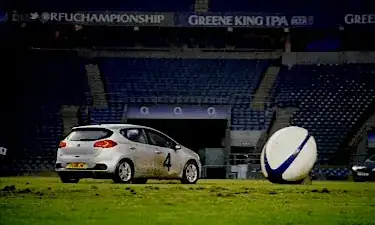
Breaking into dance
Mecha joints are different than a human's, allowing you to Rock That Body in fascinating new ways.
- 141,440
- 29
- 264
- 586
-
-
4@NoName is it really football if you use your hands to carry the ball instead of using your feet to kick it around? – The Square-Cube Law Aug 23 '21 at 03:03
Any Large Scale Construction
Currently, construction crews have a very limited number of cranes hoisting beams into position one at a time having to very slowly and precisely lower beams into position for humans to attach into place. The frame of the construction means that only something capable of climbing like a human can actually get to the top most level where the beams are being attached, and the weight of the beams means that the crane is largely responsible for positioning and alignment since any major adjustment would be too hard to do by hand.
If you had mechs instead of humans attaching the beams, then your cranes could lift entire stacks of beams up to the roof where mechs could take them and fit them into position themselves immediately freeing up the crane for the next load of steel, glass, insulation, or whatever else is needed next.
- 92,078
- 7
- 128
- 363
Clearing the rubble from the collapsed World Trade Centers and the Surfside condominium collapse would have been a heck of a lot easier.
- 17,593
- 2
- 39
- 80
As I understand the question, what you're asking isn't just "what use could we put mechs to" but "why use mechs rather than regular vehicles." Sadly, there aren't many reasons... at least not many good reasons.
(I'm going to have to ignore the technology tag. Mechs aren't very realistic for a variety of reasons, but I'll do my best to ignore that.)
The main advantage a mecha has over a tracked or wheeled vehicle is maneuverability. A human-form mecha can go places that a classic vehicle simply can't. No matter how many arms you stick on a tank it's not going to climb a ladder, or a cliff, or anything with too steep a grade. While treads and wheels are ideal for reasonably flat surfaces, they're really bad when it comes to vertical motion. Of course some mecha are also terrible at this, so it's not universal.
Human-form mecha (because not all of them look like metal people) have a lot of the same sort of movement options as humans. They can crouch, kneel, bend down to reach into a hole and so on. Depending on the control interface a human pilot may be far more in tune with the motion, giving them a much better degree of control than someone sitting at - or even plugged in to - the controls of a crane, hoist or other similar vehicle. Or the pilot could be pushing a bunch of joysticks around and letting the on-board computer handle the motion, but then they're going to be far less useful. Let's ignore that option.
So where would this be useful?
Construction & Repair
Cranes are cool and all, and hoists are fine for moving things around the job site, but sometimes it's just not that simple. There's always that one guy who wants to build his mansion on the side of some mountain, or an evil gen... I mean differently-moral person of excess intellect who wants to build his base of operations in a cave or something. Sure you can do it all with cranes, temporary scaffolding and so on, but sometimes it's just easier to walk the materials to the site and hold them in place while someone welds the rivets in place.
Likewise when you're trying to repair damaged structures, a mecha on site to help with the super-heavy lifting and bracing would be a god-send.
A mecha could potentially fill multiple roles previously handled by several different machines. Lifting, carrying, digging, hammering big spikes into little holes... you know, Big Dumb Brute stuff, just on a whole other scale.
Disaster Recovery
Mecha are often depicted as being able to detect all kinds of motion, noise, heat and so on. When an earthquake hits, or someone blows up a building or something, a team of S&R mechs would be able to locate survivors and clear rubble by "hand" far quicker and more effectively than a team of humans with diggers and cranes. They'd have to be more careful about dislodging the debris and potentially crushing survivors of course, but their strength would allow them to brace unstable areas far more effectively than humans with hydraulic jacks (very slow) and wood or steel beams.
Best to have a team of engineers overseeing them though. Cross-training pilots in disaster engineering will help, but they're probably never going to be experts.
Emergency Response
Fire-fighting, especially with bush- and forest-fires, is dangerous and demanding work. A pilot in a heat-resistant mecha can charge into the heart of the fire and spray retardants, disperse fuel concentrations or just stamp on the damn fire until it gives up. Hell, just running through the forest might be enough to clear a fire break if you're in a big enough mech.
Manueverability counts here too. Mechs can access locations that a fire engine or ambulance can't easily get to. Once they arrive they can deal with the emergency directly, extract the wounded and get them to safety - the nearest hospital or, more likely, the nearest ambulance with a clear run to a hospital. While a helicopter is faster getting the people where they need to go they pretty much suck at the rest of the operation.
Crowd Control
This one's pretty obvious. Unless your protestors came loaded for mech, they're unlikely to be able to do much against you. Squishies tend to run away when the mechs start walking towards the crowd, unless they (foolish mortals that they are) think that you won't step on them.
Oh, we can't just kill them all? OK. I'll withdraw this one.
Sports
Oh boy, the possibilities. Mech Soccer. Mech Racing. Mecha Rodeo! Mech Boxing!! F@$king Superstars of Mecha mother-f&#king Wrestling!!!
Ahem... sorry, let me just wipe that spittle off your face there. My bad.
I'd hate to be the guy designing the rings for those matches, but they'd be glorious to watch. Glorious I tell you!
- 7,205
- 13
- 27
Depending on the style of mech, I think its greatest advantages over traditional machinery would probably be in its ability to manipulate objects with precision, and (assuming it has legs), its ability to navigate very irregular terrain. I can see mechs being useful in industries like logging and mining. They'd probably be quite useful for demolition in heavily-populated areas, since they'd give the operator a lot more control over the demolition.
- 486
- 2
- 6
They can be used to play epic football with very big ball :-) it sounds stupid, but imagine football match, when everybody operates building size mecha
- 5,815
- 2
- 20
- 35
Anywhere where tracked/wheeled machinery can't function
This is identical to my answer on war-mechs. They cannot compete with tracked or wheeled vehicles. They can only supplement them. Use them anywhere where heavy machinery would be needed, but tracks or wheels don't work. Like the Logging answer above, for this often regular vehicles are used, but mountainous forests are hardly exploited because these vehicles can't work there.
So construction in mountains, heavy forests (where you can't cut a way for vehicles). As opposed to some other answers I wouldn't recommend swamps due to the higher load-per-area on legs over tracks (except if its swamp with enough rock-islands)
- 4,157
- 1
- 14
- 22
In theory, just about any human manual labor.
Lets assume for a moment that we have a Pacific Rim type mech, but of a more reasonable 6m height. Tall enough to house a human upright inside the torso. Its controls are just one person and possibly using neural interfaces. A smaller +/- 3m version could likely be made as well.
Such a mech would be able to handle any human labor task.
- Give it a shovel and it can dig trenches with an accuracy and speed that puts an excavator of the same size to shame.
- It can quickly stack prefab materials into makeshift walls, houses, bunkers, storage facilities etc.
- It is excellent for deconstructing/demolishing of trees, buildings, fences, walls etc.
- It could be used as a makeshift farming tool, although tractors are such advanced vehicles in that field nowadays that its hard to compete.
- especially the smaller version would be absolutely excellent at logistics inside large storage facilities and when loading/unloading vehicles.
- any other manual labor with and without tools you can think off.
Other mechs, like the spider mech, could also have some legs fitted out with tools on one or two feet. You could turn the leg into an excavator, demolishig tool, a small crane or forklift etc.
- 45,321
- 2
- 62
- 186
-
They sound like fun, but all that mass pressing down on the small foot area might be a problem. Hard to dig a nice clean trench when you're constantly knee-deep in the soil. Like trying to dig a trench in heavy mud. – Corey Aug 24 '21 at 02:38
-
@Corey and why would they have a small foot area in the first place? Thats like designing a tractor with car wheels rather than the oversized wheels with massive grooves. An important rule of designing anything: don't use an old design you know will fail, design a new one for the task. You imagine the feet that game/movie designers make, rather than the feet that an actual real-life designer would make with the technology level of a mech. Well-designed feet can have incredible surface area's since they don't need to turn in one direction to move. – Demigan Aug 24 '21 at 05:59
-
You ever try to walk in snow shoes? Your proposed big-foot design would be much the same. It restricts mobility, making it hard to do anything but shuffle forwards and backwards, with an occasional bit of side-step. This is a cube-square problem. Scale up a human-scale mech to double height and the volume (and mass) increase to 8x while the area of the foot increases by 4x. At 10 meters the mass is 125x the starting point, while foot area is only 25 times. You'd need to multiply the foot area by 5 to get back to parity... and that's for a small mech. Physics is a stone bitch. – Corey Aug 24 '21 at 13:37
-
@Corey that is exactly the problem. You use a snowshoe, which restricts biological functions of the foot and ankle, rather than redesigning them into snowfeet. You would not design a mech's foot and then take away functions by shoving a shoe on it. Imagine if I were to say "skates only work on smooth bicycle paths and you take them off the moment you het anywhere and they are too small for cars to ever work". You would point out that you have to redesign the wheel and its propulsion. – Demigan Aug 24 '21 at 15:24
-
As for square cube law, tracks suffer from that more than legs. You could design a 16-wheeler truck with 16 legs, but a tracked 16-wheeler would not work. That is because the tracks limit the length of the vehicle, because the longer you make it the less weight needs to be on the tracks so they can slide across the ground. Hint: everything suffers from the square cube law in one way or another, that does not mean its automatically impossible. – Demigan Aug 24 '21 at 15:27
-
That's silly. If your feet were the size of snow shoes then you'd have the same mobility issues. It doesn't matter if you design it that way or add the extra area later, it's still going to restrict mobility. And yeah, tracks (and wheels too) also have to account for this, which is why things like the NASA crawler have multiple tracks rather than one big one on each side. – Corey Aug 25 '21 at 00:00
-
@Corey that is silly, because adding the snowshoes means more mobility issues. It removes part of the mobility and articulation of the foot and ankle. And comparing biological systems to mechanical ones is even sillier. Try cycling or skating across mowed grass, then across unmowed grass. You can't even move. Does that mean wheels are useless for cross-country? No again, because as always it is silly to make these comparisons and assume that translates to a mechanical version. – Demigan Aug 25 '21 at 03:16
-
Snow shoes don't interfere with joint motion or anything, they're just awkward because of the change in geometry. It doesn't matter if that geometry was built into a boot or strapped onto a boot, and building a mecha foot with a larger surface area is the same. This is disanalogous to your bike example which is talking about different environments not wheels with different restrictions on motion. Snow shoes are a far more apt analogy since they do little else than expand the area of the foot. – Corey Aug 25 '21 at 06:21
-
-
May I add something? While it certainly IS hard for a human to walk with that bigger feet, it should be noted that a mecha can be humanoid without adhering to EVERY LITTLE PIECE OF GEOMETRY of the human. Unlike evolution, you have an easy time messing around with stuff. Why stick to having the legs so close together, when you could spread them out to make it easier to use? Or any other possiblr configuration to make this idea easier? – KombatAce Sep 10 '21 at 06:57
This is not immediately an answer, but I want to suggest approaching this backwards. I recognise that it could be entirely unsuitable for the OP’s fixed criteria.
There are answers here, and in the following…
Plausible Reasons for usage of Combat Mecha
… that basically point out that tracks are better than wheels for mobility, and that a compact shape is generally more appropriate than the opposite.
I suggest, then, that the answer is to design the environment — or at least some applicable part of it — around the distinctive aspect(s) of a “mech”. In other words… if the task is to have something mobile, with hydraulic arms, then a wheeled or tracked vehicle with hydraulic arms is better, generally [which is undesirable here].
Conversely, then, the question is not, “What can a vehicle with legs be used for, that a vehicle with tracks can not?”, but, “Why does our vehicle have to have legs?”. (The point that this is better for reaching vertically has been mentioned.) Note that this would make it no longer a question of… what additional uses can be made, of a military machine.
• Perhaps there are native animals that will attack anything that looks out of place to them… so an appropriately coloured (say) 6-legged insect shape is safer than a box that moves.
• Perhaps the ground is made up of super-scale sand — “boulders” that are super-light and strong, and can and will roll around under any sort of wheel. (It would have to be either that these can not be crushed by a heavy tracked vehicle, or that crushing them is undesirable (e.g. sharp edges, or they are a life form).)
• Perhaps the terrain is like grass is to an insect, and climbing is a fundamental part of getting around… or it is a web of strands going in every direction, with significant height, and bending around strands is necessary (as well as continuously climbing horizontally). In the same vein, one could have the strands further apart, and again travel being about getting from strand to strand.
• Perhaps the ground contains something — presumably organic — that is like mines in that something undesirable happens if and when one treads on one. Thus, a wheeled or tracked vehicle is disadvantaged against something that can step wherever it wills. (One possibility is crossing lines of something sticky.)
• Perhaps exerting more pressure on the ground is advantageous — it is often slippery and slightly spongy, or there is a thick surface layer with appropriate properties. (I believe that ice-skating uses the physics fact that ice melts locally under pressure; perhaps something could be made of this, in this vein.)
• Perhaps it is a very low-gravity environment.
• Perhaps the ground is completely covered in something crushable, that should not be crushed — and whose elements or members can be stepped-between — such as a crop. This is very much like the mines idea, except that the scale of the thing is smaller.
Conversely, some of these could probably be addressed by modifying tracks appropriately.
- 101
- 3
